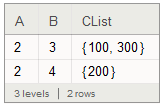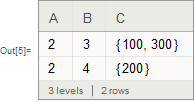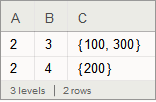I have a dataset ds with 3 columns named A, B, C. Columns A and B have repeated values. How can I obtain another dataset that contains a list of the values in C for each of the unique combinations of A and B?
For example,
ds = Dataset[ {<| "A" -> 2, "B" -> 3, "C" -> 100 |>, <| "A" -> 2, "B" -> 4, "C" -> 200 |>, <| "A" -> 2, "B" -> 3, "C" -> 300 |>}] I want to get
Dataset[ {<| "A" -> 2, "B" -> 3, "Clist" -> {100, 300} |>, <| "A" -> 2, "B" -> 4, "Clist" -> {200} |>}] How can I do that?




